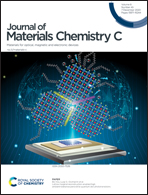Universal polymeric bipolar hosts for highly efficient solution-processable blue and green thermally activated delayed fluorescence OLEDs†
Abstract
In this study, two polymeric host materials, P(NmCP) and P(mCP), were synthesized, and high-performing sky-blue and green thermally activated delayed fluorescence organic light-emitting diodes (TADF-OLEDs) were achieved. The simple structure polymer host was designed by inserting a pyridine group into the core of P(NmCP) and an electron-donating phenyl group into the core of P(mCP). The two polymeric hosts exhibited high triplet energies (T1 = 3.04 eV for P(NmCP) and 3.05 eV for P(mCP)), which were sufficiently high to realize blue and green TADF-OLEDs. In brief, solution-processed OLEDs with an emissive layer bearing P(NmCP) as a bipolar electron host exhibited remarkable performance with a maximum current efficiency (CE), power efficiency (PE), and external quantum efficiency (EQE) of 70.36 cd A−1, 63.15 lm W−1, and 20.07%, respectively, in the green-emitting device. In the blue-emitting device, we obtained a maximum CE, PE, and EQE of 27.13 cd A−1, 22.30 lm W−1, and 10.70%, respectively. The polymer design with such a high T1 value is believed to be the cornerstone for implementing high-performance TADF-OLEDs via solution processing in the future.



 Please wait while we load your content...
Please wait while we load your content...